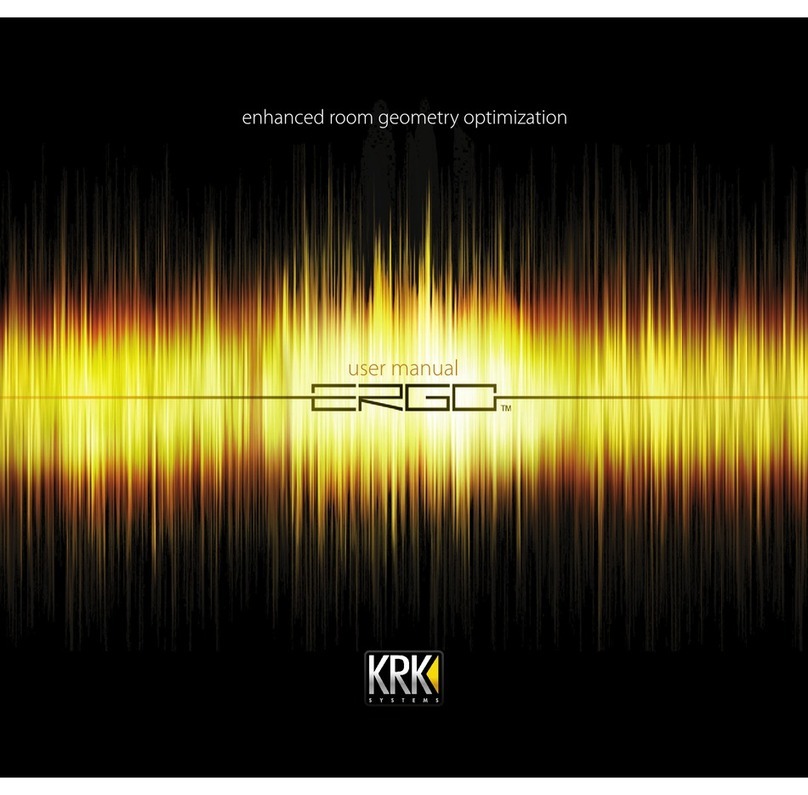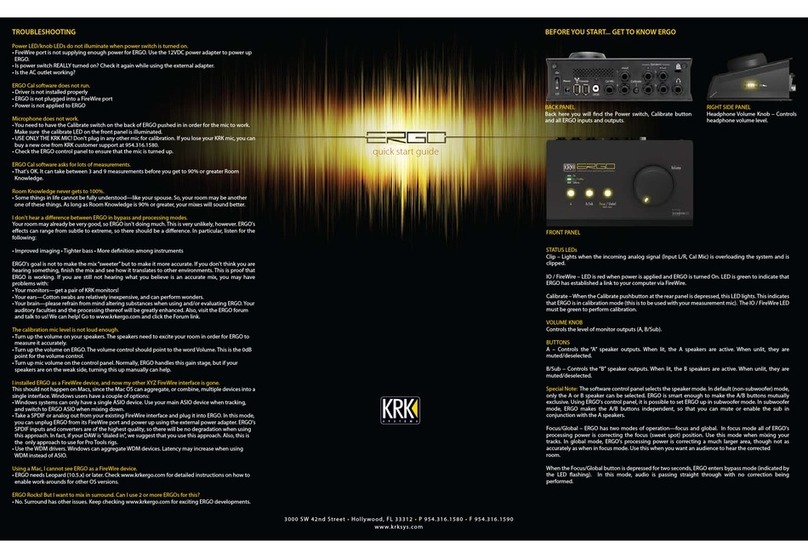KRK ERGO User manual


Page | 2
IMPORTANT SAFETY INSTRUCTIONS
CAUTION: THE LIGHTNING FLASH WITH AN ARROWHEAD SYMBOL WITHIN AN EQUILATERAL
TRIANGLE IS INTENDED TO ALERT THE USER TO THE PRESENCE OF UN-INSULATED DANGEROUS
VOLTAGE WITHIN THE UNITS ENCLOSURE THAT MAY BE OF SUFFICIENT MAGNITUDE TO
CONSTITUTE A RISK OF ELECTRIC SHOCK TO PERSONS.
WARNING: THE EXCLAMATION POINT WITHIN AN EQUILATERAL TRIANGLE IS INTENDED TO ALERT
THE USER TO THE PRESENCE OF IMPORTANT OPERATING AND MAINTENANCE (SERVICING)
INSTRUCTIONS IN THE LITERATURE ACCOMPANYING THE PRODUCT.
NOTE: THE HAND WITHIN AN EQUILATERAL TRIANGLE IS INTENDED TO ALERT THE USER TO
SPECIFIC GUIDANCE AND INFORMATION REGARDING THE OPERATION OF THE UNIT, AND SHOULD
BE READ FULLY BEFORE USING THE UNIT FOR THE FIRST TIME.
CAUTION: TO REDUCE THE RISKS OF FIRE OR ELECTRIC SHOCK DO NOT REMOVE ANY COVERS,
OR OPEN THE UNIT. THERE ARE NO USER-SERVICABLE PARTS INSIDE. ALL SERVICING SHOULD BE
REFERRED TO QUALIFIED SERVICE ENGINEERS.
WARNING: READ AND FOLLOW ALL THE SAFETY AND OPERATING INSTRUCTIONS BEFORE
CONNECTING OR USING THIS UNIT. RETAIN THIS USER MANUAL FOR FUTURE REFERENCE. ALL
WARNINGS ON THE UNIT AND ITS PACKAGING SHOULD BE READ AND FOLLOWED.
WARNING: This product contains a chemical known to the State of California to cause cancer and birth defects
or other reproductive harm.
CAUTION: To reduce the risks of fire or electric shock do not expose this product to rain or moisture. Do not
use this product near water; for example, near a bath tub, washbowl, kitchen sink, laundry tub, in a wet
basement or near a swimming pool. Unplug the unit from the wall outlet before cleaning. Never use thinner,
cleaning fluids, solvents or chemically impregnated cloths. For cleaning always use a soft dry cloth. Unplug this
product during lightning storms or when unused for long periods of time.
.
CAUTION: The unit should be installed so that its location or position does not interfere with its proper
ventilation. For example, it should not be situated on a bed, sofa, rug or similar surface that may block the
ventilation openings; or placed in a built-in installation, such as a bookcase or cabinet, that may impede the flow
of air through its ventilation openings. The unit should be situated from heat sources such as radiators, heat
registers, stoves or other devices (including amplifiers) that produce heat. No naked flame sources, such as
lighted candles, should be placed on, or near the unit.
WARNING: Do not place this unit on an unstable surface, cart, stand or tripod, bracket or table. The unit may
fall, causing serious injury to a child or adult and serious damage to the unit. Use only with a cart, stand, tripod,
bracket or table recommended by the manufacturer or sold with the unit. Any mounting of the device on a wall
or ceiling should follow the manufacturer’s instructions and should use a mounting accessory recommended by
the manufacturer. An appliance and cart combination should be moved with care. Quick stops, excessive force
and uneven surfaces may cause the appliance and cart combination to overturn. Use only with the cart, stand,
tripod, bracket, or table specified by the manufacturer, or sold with the apparatus. When a cart is used, use
caution when moving the cart/apparatus combination to avoid injury from tip-over.
NOTE: Should the unit become damaged beyond repair, or reaches the end of its life, please consult the
regulations regarding disposal of electronic products in your region.
NOTE: KRK Systems, LLC cannot be held responsible for damage, and, or including data loss caused by
improper use of the unit and or the applications provided for use with the unit.

Page | 3
IMPORTANT SAFETY INSTRUCTIONS
CAUTION TO PREVENT ELECTRIC SHOCK, MATCH WIDE BLADE OF PLUG TO WIDE SLOT FULLY
INSERT.
ENGLISH:The apparatus shall be connected to a Mains socket outlet with a protective earthing connection.
GERMAN:Das Gerät ist eine Wandsteckdose mit einem Erdungsleiter angeschlossen werden.
FRENCH:L'appareil doit être connecté à une prise secteur avec connexion à la terre.
SPANISH:El aparato estará conectado a una toma de red eléctrica con una conexión a tierra.
ITALIAN: L'apparecchio deve essere collegato a una presa di rete con una connessione a terra protettiva.
1. The unit and power supply should only be connected to a power supply outlet only of the voltage and
frequency marked on its casing.
2. Protect the power cable from being walked on or pinched particularly at plugs, convenience receptacles,
and the point where they exit from the apparatus.
3. Do not defeat the safety purpose of the polarized or grounding-type plug. A polarized plug has two blades
with one wider than the other. A grounding type plug has two blades and a third grounding prong. The
wide blade or the third prong is provided for your safety. If the provided plug does not fit into your outlet,
consult a qualified electrician for replacement of the obsolete outlet.
4. If the mains plug supplying this product incorporates a fuse then it should only be replaced with a fuse of
identical or lower rupture value.
5. Never use a damaged or frayed power cable; this can introduce serious risk of exposing lethal voltages.
6. The power supply cable of the unit should be unplugged from the wall outlet when it is to be unused for a
long period of time.
7. Only use attachments/accessories specified by the manufacturer.
DO NOT ATTEMPT SERVICING OF THIS UNIT YOURSELF. REFER SERVICING TO QUALIFIED SERVICE
PERSONNEL.
Upon completion of any servicing or repairs, request the assurance that only Factory Authorized Replacement
Parts with the same characteristics as the original parts have been used, and that the routine safety checks
have been performed to guarantee that the equipment is in safe operating condition.
REPLACEMENT WITH UNAUTHORIZED PARTS MAY RESULT IN FIRE, ELECTRIC SHOCK OR OTHER
HAZARDS.
ATTENTION POUR …VITER LES CHOC ELECTRIQUES, INTRODUIRE LA LAME LA PLUS LARGE DE LA
FICHE DANS LA BORNE
CORRESPONDANTE DE LA PRISE ET POUSSER JUSQUíAU FOND.
This unit should be serviced by qualified service personnel when:
The power cord or the plug has been damaged
Objects have fallen, or liquid has been spilled into the unit
The unit has been exposed to rain or liquids of any kind
The unit does not appear to operate normally or exhibits a marked change in performance
The device has been dropped or the enclosure damaged.
REGULATORY CERTIFICATION
KRK declare under our sole responsibility that this product, to which this declaration relates, is in conformity with the
following standards:
The Declarations of Conformity can be obtained from 382 Ave. de la Couronne, B-1050 Brussles
Authorized European representative: Phone: +3226450500 Fax: +326450505

Page | 4
Contents
Introduction ............................................................................................................................................................ 5
1.Method of Use ................................................................................................................................................ 5
2.ERGO and RoomPerfect™.............................................................................................................................. 6
3.Features ......................................................................................................................................................... 7
5.How ERGO works ............................................................................................................................................ 8
6.System Block Diagram.................................................................................................................................... 8
7.Back Panel Connections.................................................................................................................................. 9
8.Front Panel Features..................................................................................................................................... 10
9.Placing your Monitoring System................................................................................................................... 11
10.Stereo Monitor Placement............................................................................................................................ 12
11.Subwoofer Placement .................................................................................................................................. 13
12.Setting Monitor and Subwoofer Levels......................................................................................................... 14
13.Connecting ERGO to your monitoring system ............................................................................................... 15
19. Connecting ERGO to your computer.............................................................................................................. 20
20.1394/Firewire considerations....................................................................................................................... 21
21.Preparing for Software/Driver Installation.................................................................................................... 22
22.Installation for Microsoft Windows Systems................................................................................................. 23
23.Installation for Apple Mac OSX Systems........................................................................................................ 26
24.ERGO Calibration .......................................................................................................................................... 29
25.Using ERGO Calibration Software (ERGO Cal) ................................................................................................ 30
26.ERGO Control Panel (Windows / Mac OSX).................................................................................................... 40
27.Specifications ............................................................................................................................................... 44
28.Frequently Asked Questions (FAQs) .............................................................................................................. 45
29.Troubleshooting........................................................................................................................................... 47
30.Glossary........................................................................................................................................................ 49
31.Further Assistance: ....................................................................................................................................... 51
32.LEGAL........................................................................................................................................................... 51

Page | 5
Introduction
Thank you for purchasing your ERGO Room Correction and Audio Interface system. If you are already a KRK thanks for
your continued use and support of our products. If you are new to KRK we are pleased that you chose ERGO as your
room correction, we welcome you to our continually growing number of users. At KRK we strive to achieve the most
honest, natural reproduction of your hard work. We encourage you to visit our website to see our industry standard
Rokit monitors, class leading VXT monitors, Subwoofer solutions and the latest addition to the KRK portfolio, the KNS
series headphones.
ERGO (Enhanced Room Geometry Optimization) is an exciting product that enhances the performance of any
loudspeaker/monitoring system by digitally correcting both common and complex acoustic problems in the room.
1. Method of Use
ERGO can be used in two main ways:
a. As an audio interface (with room correction) to hardware running Apple Mac OSX (Core Audio) or
Microsoft Windows (DirectX-WDM/ASIO) operating systems, allowing full access to audio input and outputs
for recording and monitoring, and room-correction.
b. As a stand-alone room correction device which sits “in-line” with your monitoring signal path. This
requires connection to your Apple Mac OSX or Microsoft Windows hardware for the room calibration process
only, once complete ERGO can be disconnected to use in stand-alone mode providing room correction to the
line input signal and supplying the corrected signal to your monitoring system
Both methods allow the following room correction options:
a. Dual Monitoring System
Two sets of stereo monitors which can be A/B switched from ERGO’s front panel
b. 2.1 Monitoring System
A single set of stereo monitors and a dedicated subwoofer, in this mode the main monitors and the
subwoofer can be individually muted when required
ERGO’s functionality is consistent between modes and all operational aspects are identical. For more on the
functionality please see the section on connecting ERGO.
Other manuals for ERGO
3
Table of contents
Other KRK Music Equipment manuals




















